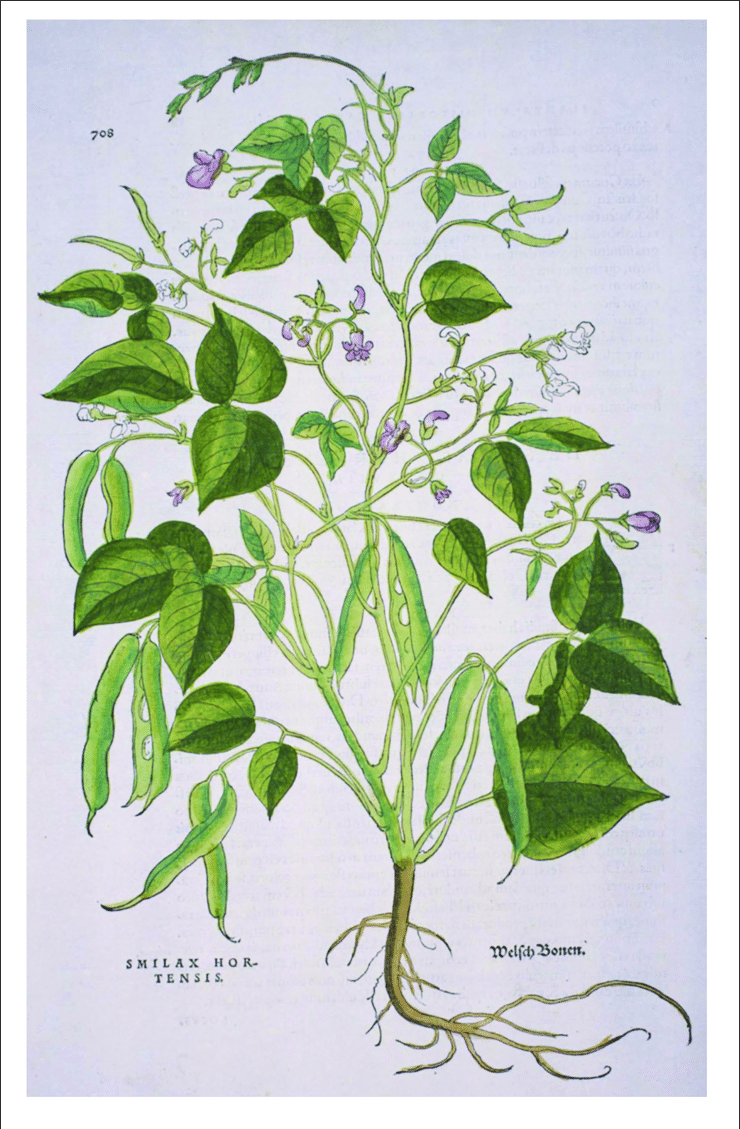When the Spanish and Portuguese arrived in the Americas in the late 15th century, beans were being grown everywhere in Mesoamerica, South America, and the Caribbean by the indigenous people. They were first introduced into the Iberian Peninsula from Central America around 1506 and from the southern Andeans in about 1532. Common bean spread rapidly in Europe, probably because of its similarity with the cowpea, V. unguiculata, which had been grown in Europe for millennia.
The early arrival of beans in Europe is widely documented in the art and books of Medieval Europe. The common bean was first depicted in the prayer book of Anne de Bretagne, Queen of France and Duchess of Brittany in 1508. Beans also appear in frescoes painted between 1515 and 1517 by Giovanni Martini da Udine at Villa Farnesina in Rome.
Common bean was described by Leonhard Fuchs in 1542 in his great Herbal. He suggested that the common bean had a climbing habit, white or red flowers, and red, white, yellow or liver-colored seed coats, with or without spots. However, he may have been describing traits belonging to both P. vulgaris and P. coccineus. Later descriptions of bean were published in herbals of Roesslin in 1550, Oellinger in 1553 and Dodonaeus in 1554.
The beginning of bean cultivation in Italy was well documented in 1532 by the Italian Renaissance humanist Pierio Valeriano who received a bag of bean seeds as compensation for his work in the court of Pope Clemente VII. The Pope had received the seeds from the Spanish Emperor Charles V. Valeriano sowed the seeds in his fields in northeastern Italy, and described their cultivation, morphology, and therapeutic properties in his poem ‘De Milacis Cultura’.
Phaseolus seeds from Italy and Spain were introduced into Hungary, as part of an exchange of botanical species and scientific information among naturalists. Detailed illustrations and descriptions of common and scarlet runner beans were included in the herbal of Netherland botanist Carolus Clusius – Stirpium per Pannonia, Austriam of 1583. By 1669, the common bean was cultivated on a large scale in Zeeland and 20 years later in Slovenia.
Beans were probably taken by the Portuguese to Madagascar and the coastal areas of eastern Africa in the sixteenth century. From there, they were likely carried inland by the Arab traders who were then active in the region. Beans were well-established as a food crop in Africa before the colonial era. Remarkably, much of the variation in seed coat, shape, and growth habit that originated in South America was maintained in the African landraces, even though the initial introductions were probably limited.
Illustration: Folio 708 from Leonard Fuchs (1542) Di Historia Stirpium showing an image of common bean (Phaseolus vulgaris). Hunt Institute for Botanical Documentation.
Bibliography
Barona, J. L. (2007). Clusius’ exchange of botanical information with Spanish scholars. In: MacGregor, A. Carolus Clusius, towards a cultural history of a Renaissance naturalist, pp. 99-116.
Debouck, D.G. and Smartt, J. (1995) Beans Phaseolus spp. (Leguminosae– Papilionideae). In: Smartt, J. and Simmonds, N.W. (eds) Evolution of Crop Plants. Longman Scientific and Technical, Harlow, pp. 287–294.
Greenway, P.J. (1944) Origins of some East African food plants. The East African Agricultural Journal, 10(1): 34-39.
Hancock, J.F. (2022) World agriculture before and after 1492: The legacy of the Columbian exchange. Springer
Martin, G.B. and Adams, M.W. (1987) Landraces of Phaseolus vulgaris (Fabaceae) in Northern Malawi. I. Regional variation. Economic Botany 41, 190–203.
Piergiovanni, A. R. and Lucia, L. (2010) Italian common bean landraces: History, genetic diversity and seed quality. Diversity 2(6): 837-862.
Zeven, A. (1997) The introduction of the common bean (Phaseolus vulgaris L.) into Western Europe and the phenotypic variation of dry beans collected in The Netherlands in 1946. Euphytica 94:319–328.
